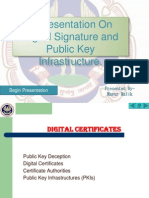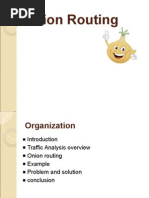Certificate Validation Using Blockchain
Uploaded by
HarshikantCertificate Validation Using Blockchain
Uploaded by
HarshikantIEEE 7th International Conference on Smart Structures and Systems ICSSS 2020
Certificate validation using blockchain
A.Gayathiri J.Jayachitra Dr.S.Matilda
IT Department IT Department Computer Science Of Engineering
IFET College of Engineering IFET College of Engineering IFET College of Engineering
Villupuram, India. Villupuram, India. Villupuram, India.
gayathiri99a@gmail.com jayachitraifetit@gmail.com matildass@gmail.com
Abstract: In the digital world, each and everything is blockchain in play, the storage of certificates are
digitalized in which the certificate of SSLC, HSC, and more secure. With these technologies, an
academic certificate are digitalized in the educational application created that facilitates the secure
institution and provided to the students. Students are validation of digital certificates.
difficult to maintain their degree certificates. For the
organization and institution, verification and
validation of certificates are tedious and cumbersome. II. LITERATURE SURVEY
Our project will help to store the certificate in the
blockchain system and provide security. First, the Jin-chiou et al [1] developed software in order to
paper certificates are converted into digital avoid counterfeiting certificates. Due to the lack of
certificates. The chaotic algorithm is used to generate an anti-forge mechanism, the graduation certificate
the hash code value for the certificate. Then the is to be forged. so, the decentralized application
certificates are store in blockchain. And these was designed based on etherum blockchain
certificates are validated by using the mobile technology. First, generate the digital certificate for
application. By using blockchain technology we can the paper certificate then hash value created for the
provide a more secure and efficient digital certificate
certificate is stored in the blockchain system. Even
validation.
Keywords: blockchain, digital certificate, hashing, a it used to verify the authenticity of the certificate it
chaotic algorithm required another scanning app to scan the
certificate. The system saves on paper, prevent
I. INTRODUCTION document forgery. But the QR-Code must be
scanned with a smartphone and an internet
Blockchain was introduced in the year 2008 by connection is required.
Satoshi Nakamoto. Blockchain is one of the online
ledgers which provide decentralized and Ze Wang et al [2] designed a blockchain-based
transparent data sharing. In this project, we design certificate transparency and revocation
an android application used to provide secure transparency system. In this system, the certificate
verification of our certificates. In nowadays, all authority (CA) signed the certificate and the
Graduation certificates and transcripts hold revocation status information of the respected
information that is easily tampered illegally by certificates are published by the subject (Certificate
individuals and should not be easily accessible to Authority). Public logs are used to monitor the CAs
outside entities. Hence, there is a high need for an operation. This system was implemented with
efficient mechanism, that can guarantee the firefox and nogix. This system provided the trust
information in such certificates is original, which but Certificate validation is delayed and a false
means the document has originated from a reliable sense of security.
and authorized source and is not forged. Various
systems have been designed to secure e-certificates Madala et al [3] used the Hyper ledger Fabric
for education institutions and to store them securely blockchain platform. In this system, the certificates
in cloud-based systems. Blockchain is the main tool are issued by CAs only by obtaining approval from
to felicitate this need and when combined with the domain owner Certificate Transparency (CT)
different hashing techniques, this becomes a technique, invented by Google. The aim to prevent
powerful method for protecting the data. It also SSL/TLS CA from issuing certificates for a domain
helps in eliminating the need for constant without visible to the owner of the domain. But
verification of certificates. Blockchain technology there was low scalability and less transaction.
is used to reduce the incidence of certificate
forgeries and ensure that the security, validity, and Aisong Zhang et al [4] designed a system based on
confidentiality of graduation certificates would be consortium blockchain technology. They used a
improved. Technologies that exist in security secret sharing scheme. It can validate the digital
domains include digital signatures, which are used certificate to protect the user’s information and also
in digital documents to provide authentication, the property of the user. The digital certificate
integrity, and non-repudiation. Also with revocation lists have collaborated among the CAs.
978-1-7281-7223-1/20/$31.00 ©2020 IEEE
Authorized licensed use limited to: INDIAN INSTITUTE OF TECHNOLOGY KHARAGPUR. Downloaded on September 11,2023 at 13:00:59 UTC from IEEE Xplore. Restrictions apply.
IEEE 7th International Conference on Smart Structures and Systems ICSSS 2020
The trust and reliable CRL(Certificate Revocation
List)are more compared with the traditional system.
If the user wants to verify the certificate, they only
need to decrypt the signature with the public key.
And the result will be compared with the hash
operation of the original message. If the result is
consistent, it proved that the digital certificate not
tampered. But there is a false sense of security.
Macro Baldi etal[5] designed a system named
certificate validation through public ledgers and
blockchain. In this system, CRLs(Certificate
Revocation List) were distributed through the use
of a private blockchain, and it shared among
CA(certificate authority).CAs are responsible for
issuing certificates to requestors who meet the
requirements and maintain CRLs. The certificate
revocation list was available and authentication was
provided at any time for a certificate. The
certificate revocation list for a set of the certificate
was maintained by the same certification authority
who issued the certificates. CA ecosystem is fragile
.
and prone to compromise.
Fig 1: Architecture of the proposed system
III. OBJECTIVES OF THE PROPOSED
SYSTEM B. Digital Certificate Creation
In this, the student certificates are converted into
By using the unmodifiable property of blockchain digital certificates. The academic certificate and
provide more security. Confidentiality is sports certificate are issued by the institution are
transparent with each transaction visible to all the stored in the database. By using the analog image
peers. Our application runs in offline mode. The to digital image conversation method the certificate
certificate is validated rapidly. Provide accurate can be converted into a digital certificate. The
and reliable information value 0's and 1's are created for each certificate. In
a digital image, all the coordinates on 2-d function
and the corresponding values are finite. Each value
IV. PROPOSED SYSTEM considered a pixel. By using admin login the
A. Methodology administrator login to our application to upload the
student's certificate in the application then it will
In this proposed system the academic, sports
convert an analog image to digital image using
certificates are converted into digital certificates
sampling and quantization. The next page of the
using sampling and quantization. Then the
application shows the add student and add a
certificates are added with the hash values
certificate. If an admin tape the add student, the
generated for the digital certificate and store it into
new student gets registered. If an admin clicks the
the blocks. The chaotic algorithm used for
added certificate, the student certificate is
generating the hash value. Each block consists of
uploaded.
the hash value, timestamp, and hash value of the
previous block. These blocks are linked together
C. Hash Code Generation
in the form of blockchain. The institution registers
The chaotic algorithm is used to generate the
the student details in our interface (application) by
hash value for the certificate. This algorithm
providing details like name, email id and these are
takes input in different size and produces the
stored in the database. The certificate issued by the
output in a fixed size. This algorithm needs to
registrar is stored in the application and they form
define the mapping scheme, initial condition,
a blockchain. The employer or verifier can
and parameters. Verifying process is started by
validate the certificate by entering the student
using the same initial condition and parameters
details.
to generate the same output. When the
certificate is uploaded, the hash value is
created for the digital certificate. Compared to
SHA-1, the chaotic hash function are collision-
resistant.
978-1-7281-7223-1/20/$31.00 ©2020 IEEE
Authorized licensed use limited to: INDIAN INSTITUTE OF TECHNOLOGY KHARAGPUR. Downloaded on September 11,2023 at 13:00:59 UTC from IEEE Xplore. Restrictions apply.
IEEE 7th International Conference on Smart Structures and Systems ICSSS 2020
D. Digital certificate validation
In this, the created digital certificate is
validated. Certificates that are stored in the
blockchain are validated by matching the hash
value. The verification of the hash value of the
certificate is used to avoid tampering. The
employer or verifier can log in to the
application using their login id and password.
They can select and certificate type which they
want to validate. Then tape the validate button
in the application. If the certificate is original
the output will be a valid certificate and
success. If the certificate is not original or
modified the output will be error and modified
certificate.
E. Working of Application
In our application the first page is admin
login, the next page consists of add student
and certificate and last verifier page. The
admin can log in to our application using the
admin login id and password. Then the admin
can add the student and their certificates by
tap the add student and add certificate button.
Next, the verifier can validate the certificate
using the verifier login id and password. They
provide the login id of the student and select Fig 3: Blockchain successful verification of
the certificate type and tap the verify button. modified certificate
If the uploaded certificates are original then
the result will be a success. Otherwise, the
V.CONCLUSION
result will be error and modified.
In this paper, we proposed a solution to the
problem of certificate forgery based on blockchain
technology. Providing security to the data is very
important. By using the unchallengeable property
of blockchain, we can provide more security for
data and reduce the certificate forgery. The
application can allow the user to view and validate
the certificate. This system guarantees information
accuracy and security and easy for people to
manage digital certificates.
VI. REFERENCES
[1] Jiin-Chiou Cheng; Narn-Yih Lee; Chien Chi; Yi-Hua
Chen, "Blockchain and Smart Contract for Digital
Certificate” IEEE International Conference on Applied
System Invention (ICASI),2018.
[2] Wang Z., Lin J., Cai Q., Wang Q., Jing J., Zha D. (2019)
Blockchain-Based Certificate Transparency and
Revocation Transparency. In: Zohar A. et al. (eds)
Financial Cryptography and Data Security. FC 2018.
Lecture Notes in Computer Science, vol 10958. Springer,
Berlin, Heidelberg.
[3] D. S. V. Madala, M. P. Jhanwar, and A. Chattopadhyay,
"Certificate Transparency Using Blockchain," 2018 IEEE
International Conference on Data Mining Workshops
(ICDMW), Singapore, Singapore, 2018, pp. 71-80, doi:
10.1109/ICDMW.2018.00018.
[4] Aisong Zhang and Xinxin Ma, "Decentralized Digital
Certificate Revocation System Based on Blockchain”,
Journal of Physics: Conference Series, Volume 1069, 3rd
Annual International Conference on Information System
Fig 2: Blockchain successful verification of and Artificial Intelligence (ISAI2018) 22–24 June 2018,
original certificate Suzhou.
978-1-7281-7223-1/20/$31.00 ©2020 IEEE
Authorized licensed use limited to: INDIAN INSTITUTE OF TECHNOLOGY KHARAGPUR. Downloaded on September 11,2023 at 13:00:59 UTC from IEEE Xplore. Restrictions apply.
IEEE 7th International Conference on Smart Structures and Systems ICSSS 2020
[5] Marco Baldi, Franco Chiaraluce, Emanuele Frontoni,
Giuseppe Gottardi, Daniele Sciarroni, and Luca Spalazzi
“Certificate Validation through Public Ledgers and
Blockchains In Proceedings of the First Italian Conference
on Cybersecurity.
[6] Nitin Kumavat, Swapnil Mengade, Dishant Desai,
JesalVarolia, “ Certificate Verification System using
Blockchain” Computer Engineering Department, Mumbai
University.
[7] S.Sunitha kumari, D.Saveetha “Blockchain and Smart
Contract for Digital Document Verification” Department
of Information Technology- SRM Institute of Science and
Technology.
[8] Omars Saleh, osman ghazali, muhammad ehsan rana,
“Blockchain based framework for educational certificates
verification” Studies, Planning and Follow-up Directorate,
Ministry of Higher Education and Scientific Research,
Baghdad, Iraq. School of Computing, University Utara
Malaysia, Kedah, Malaysia.
[9] Trong Thua Huynh, Trung Tru Huynh, Dang Khoa Pham,
Anh Khoa Ngo, “Issuing and Verifying Digital
Certificates with Blockchain”
https://dx.doi.org/ 10.1109/ATC.2018.8587428.
[10] Maharshi Shah, Priyanka Kumar, “Tamper Proof Birth
Certificate Using Blockchain Technology” International
Journal of Recent Technology and Engineering (IJRTE).
978-1-7281-7223-1/20/$31.00 ©2020 IEEE
Authorized licensed use limited to: INDIAN INSTITUTE OF TECHNOLOGY KHARAGPUR. Downloaded on September 11,2023 at 13:00:59 UTC from IEEE Xplore. Restrictions apply.
You might also like
- Unit II - Ethereum Overview - Blockchain NotesNo ratings yetUnit II - Ethereum Overview - Blockchain Notes25 pages
- Blockchain For Cybersecurity A Comprehensive Survey100% (1)Blockchain For Cybersecurity A Comprehensive Survey6 pages
- Cybrary - Computer and Hacking ForensicsNo ratings yetCybrary - Computer and Hacking Forensics3 pages
- Certificate Verification System Based On Blockchain TechnologyNo ratings yetCertificate Verification System Based On Blockchain Technology5 pages
- ITB1 Documentation Detection of Phishing Website Using MLNo ratings yetITB1 Documentation Detection of Phishing Website Using ML49 pages
- Slides Dan+tanja 20220825 Pqcrypto 16x9No ratings yetSlides Dan+tanja 20220825 Pqcrypto 16x957 pages
- Explain Each of The Following Symmetric Key Algorithms in 50-100 and List at Least Two (2) Usages For Each of Symmetric Key Algorithms100% (1)Explain Each of The Following Symmetric Key Algorithms in 50-100 and List at Least Two (2) Usages For Each of Symmetric Key Algorithms9 pages
- CHFIv9 Module 12 Investigating Email CrimesNo ratings yetCHFIv9 Module 12 Investigating Email Crimes54 pages
- PQC Migration Project Description DraftNo ratings yetPQC Migration Project Description Draft16 pages
- Towards Post-Quantum Blockchain A Review On Blockchain Cryptography Resistant To Quantum Computing AttacksNo ratings yetTowards Post-Quantum Blockchain A Review On Blockchain Cryptography Resistant To Quantum Computing Attacks26 pages
- Practical Manual of Ethical Hacking TYBSC CS.docxNo ratings yetPractical Manual of Ethical Hacking TYBSC CS.docx46 pages
- Detecting Phishing Website With Code ImplementationNo ratings yetDetecting Phishing Website With Code Implementation13 pages
- Explorning The Role of Machine Learning in Enhancing Cloud SecurityNo ratings yetExplorning The Role of Machine Learning in Enhancing Cloud Security5 pages
- Whitepaper CRYPTOCURRENCY INVESTIGATIONS - A Comprehensive Guide For Law EnforcementNo ratings yetWhitepaper CRYPTOCURRENCY INVESTIGATIONS - A Comprehensive Guide For Law Enforcement12 pages
- A Review of Prospective Applications of BlockchainNo ratings yetA Review of Prospective Applications of Blockchain22 pages
- Quantum Cryptography Beyond Quantum Key Distribution: Anne Broadbent Christian Schaffner100% (1)Quantum Cryptography Beyond Quantum Key Distribution: Anne Broadbent Christian Schaffner32 pages
- Quantum Computing Cyber Security 1689695783No ratings yetQuantum Computing Cyber Security 168969578312 pages
- Block Chain: Ilma University (Formerly Ibt)No ratings yetBlock Chain: Ilma University (Formerly Ibt)15 pages
- Predicting Phishing Websites Based On Self-Structuring Neural NetworkNo ratings yetPredicting Phishing Websites Based On Self-Structuring Neural Network17 pages
- Blockchain and Cryptocurrency TechniquesNo ratings yetBlockchain and Cryptocurrency Techniques14 pages
- Android Security A Survey of Issues, Malware Penetration Dan DefenseNo ratings yetAndroid Security A Survey of Issues, Malware Penetration Dan Defense24 pages
- Multi-Factor Authentication Using Cryptography and SteganographyNo ratings yetMulti-Factor Authentication Using Cryptography and Steganography5 pages
- Automated Analysis and Deobfuscation of Android Apps & MalwareNo ratings yetAutomated Analysis and Deobfuscation of Android Apps & Malware84 pages
- Cryptography (CSC316) : Unit I: Introduction and Classical CiphersNo ratings yetCryptography (CSC316) : Unit I: Introduction and Classical Ciphers31 pages
- Education Degree Fraud Detection and Student Certificate Verification Using Blockchain IJERTV9IS070156No ratings yetEducation Degree Fraud Detection and Student Certificate Verification Using Blockchain IJERTV9IS0701564 pages
- Configuring IPCop Firewalls: Closing Borders with Open SourceFrom EverandConfiguring IPCop Firewalls: Closing Borders with Open SourceNo ratings yet
- Ethical Hacking for All: Complete A to Z Tips and Tricks to Ethical Hacking MasteringFrom EverandEthical Hacking for All: Complete A to Z Tips and Tricks to Ethical Hacking MasteringNo ratings yet
- Lab - Develop Cybersecurity Policies and ProceduresNo ratings yetLab - Develop Cybersecurity Policies and Procedures4 pages
- Foundations of Cryptography (CYS 602) : Lecture #1 Introduction To Cryptography and Data SecurityNo ratings yetFoundations of Cryptography (CYS 602) : Lecture #1 Introduction To Cryptography and Data Security13 pages
- Bitdefender-GravityZone Small Business Security DatasheetNo ratings yetBitdefender-GravityZone Small Business Security Datasheet2 pages
- Oracle Commerce ATG: Advanced Profile Management100% (1)Oracle Commerce ATG: Advanced Profile Management43 pages
- PCI CP v1 1 ROC Reporting Template Logical Form100% (1)PCI CP v1 1 ROC Reporting Template Logical Form78 pages
- Doncaster - Cyber Security Case Study FinalNo ratings yetDoncaster - Cyber Security Case Study Final7 pages
- Whitepaper SolarWinds Orion Supply-Chain AttackNo ratings yetWhitepaper SolarWinds Orion Supply-Chain Attack9 pages

























































































